The former Soviet state of Kazakhstan is famed as the birthplace of the apple but two Washington State apple industry people who went on a mission trip there earlier this year found few orchards. And most of the orchards that did exist resembled those in Washington a generation ago with trees planted at low densities.
Steve Weber, an apple grower, agricultural lender, and realtor based in Yakima, Washington, said he was struck by the challenges that Kazakh growers face in updating their orchards. Modern-day orcharding is capital intensive, and it was immediately apparent that obtaining capital in Kazakhstan is difficult and a limiting factor.
Weber and his travel companion Keith Mathews, chief executive officer of FirstFruits Marketing in Yakima, learned that the once abundant fruit-growing region in the Ili River Valley, in southeastern Kazakhstan, fell victim to the economic collapse of the Union of Soviet Socialist Republics in the 1980s as state farms lost their subsidies and state-sponsored markets disappeared.
A final blow came in 1985 when Soviet leader Mikhail Gorbachev launched an anti-alcohol campaign, which led to the destruction of thousands of hectares of vineyard and orchard.
Orchard area in Kazakhstan fell from more than 150,000 acres to less than half that, and what remained fell into disrepair.
The Middle Earth Orchards Group LLC, based in Colorado, has training centers in Kazakhstan to help young growers who lack resources and horticultural knowledge to improve their fruit production and progress in their lives. Mathews said Stan and Tammy Brown, who established the organization 19 years ago, have dedicated their lives to this cause, patiently focusing on helping to change one life at a time.
MEO also organizes volunteer mission trips to Kazakhstan for U.S. fruit industry people. Those who have visited the area include Larry Knudson, Fred Nyberg, Tom Hale, and Fred Scarlett, as well as Weber and Mathews.
The Kazakh government, which wants to see the abandoned land put back into productive use, is making land available and subsidizing orchard plantings. Those who are able to put a little cash together can obtain a 49-year lease on a few hectares and eventually pay it off and own the land. There are about 2.5 acres to a hectare. Mathews said the young growers are thankful for the opportunity to get a step up and move forward.
Weber pointed out, however, that the planting subsidy has been paid on a per-hectare basis, which was a disincentive to plant trees on modern, high-density systems. Growers felt they were better off spreading their trees over more hectares. The government has begun to monitor the subsidy program and to encourage modern systems.
One of the problems growers have had in establishing orchards has been the lack of a reliable source of trees and rootstocks.
“I don’t think the farmer had any clue what he was buying, and he could not buy a thousand trees alike, so you couldn’t manage that orchard well,” Mathews said. “When you have a half-acre with ten different things on it, it’s impossible to spray at the right time and engage in good horticultural practices.”
The MEO Group has started a nursery and launched a for-profit business selling quality nursery trees and trellis materials to growers. Profits fund the nonprofit training program for small-scale family growers.
Low-input system
Because of financial contraints, growers have been using a low-input system to minimize growing costs. Most Kazakh fruit is grown only for the local markets, and little is exported.
“In Washington State, the guy who’s trying to do it on half a checkbook is generally the guy who doesn’t succeed,” Weber said. “You either grow the quality required to get the apples in the box, or you’re out.”
Washington growers need to prune the trees, thin the crop, and use all kinds of inputs, such as fertilizer, so that the fruit is good enough to be sold all over the world, he pointed out.
“I didn’t see the amount of input costs that we would be required to put in to produce a high-quality product,” Weber said. “But I think they have a market that’s satisfied with second-tier product. If your input costs are half as much, maybe you can receive half the price and make it work.”
Most of the growers sell their apples independently. Although some of the fruit is sold in retail stores in the country’s largest city, Almaty, much of the crop is sold in the fall and winter from roadside stands or from the back of a truck.
“That’s the market they have,” Weber said. “The farmers are smart enough to realize, ‘I’m not going to spend more money to put a beautiful box together if I don’t get paid for it.’”
Some growers have small, unsophisticated storage rooms where they can keep fruit for four to five months after harvest, so they’re not selling it during the glut of production, Mathew said. There is little controlled-atmosphere storage.
One grower they visited had taken a regular storage room and filled every crack he could find with spray foam, so that when the door was locked, it would create low-oxygen conditions.
The highway running through the Ili Valley links Almaty to China. Chinese apple growing areas are a five-day drive away, and Chinese Fuji apples are trucked to Kazakhstan at a cost of U.S.$6 per carton plus $8 for transportation and sell for $20 wholesale. The retail price for Chinese apples is about 500 Kazakh tenge per kilo ($1.25 a pound), compared with 300 to 350 tenge (75 to 85 cents a pound) for local apples.
In a market there, Weber and Mathews saw Gala apples from Double Diamond Fruit Company in Quincy, Washington, which had probably been imported via St. Petersburg, Russia, and trucked the 2,500 miles to Almaty, as there are no direct imports from the United States.
Wealth
In Almaty, a city of 2 million people, there are signs of wealth. It has western clothing stores, like Saks Fifth Avenue, and Metro, a German grocery chain similar to Sam’s Club. It also has the largest Lexus car dealership in Asia.
However, outside the city, poorly built Soviet-era buildings and other infrastructure are in disrepair.
“Almaty looks pretty good,” Weber said. “But the other areas we were in were pretty poor looking.”
Most of the roads were gravel. Some were paved, but had so many potholes that Weber wondered how the growers could drive their fruit to market without it being badly bruised.
Weber said he was interested to see how fruit was grown in Kazakhstan, and he and Mathews tried not to discourage anyone.
“We certainly gave people encouragement,” he said. “They are wonderful, nice people. Everybody’s just trying to make a living and provide a place for their families, but these guys have a tough row to hoe.” •

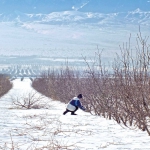
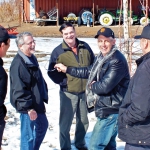
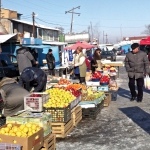
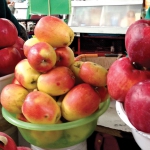
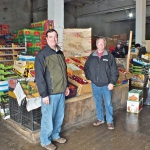
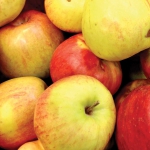






Thank you, Geraldine, for this really very interesting article.
Just now some people contacted us concern project of new apple plantation in Kazachstan.
For us as fruit nursery it is “terra incognita”. Eva Sedlakova, Plantex, Slovakia
We are an Italian manufacturer specialized in pneumatic and electro-mechanical pruning/harvesting equipment for orchards, vineyards, blueberries, olives, coffee and similar crops and we looking for a distributor in Kazachstan.
We would much appeciated if anyone could help us to establish a contact with a distributor in Kazachstan.
Sincerely – Dario
Dear Geraldine,
thank you very much for the information. It is very helpful.
I am from Kyrgyzstan and I want to start small project with growing trees in my garden and ti see how it goes. I would appreciate if you share the contact of tree nursery in Kazakhstan helping with rootstocks to growers.
Thank you in advance,
Liliya